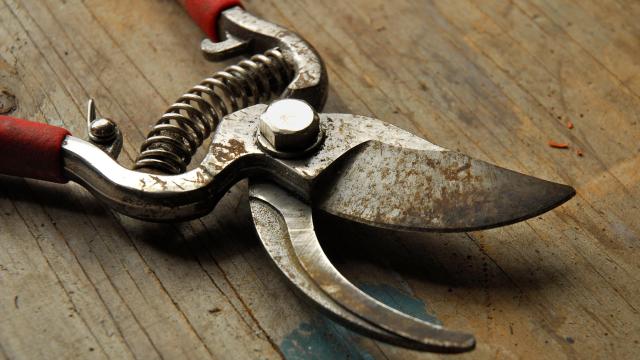There’s nothing quite like the satisfying sound a sharp pair of sears makes when you’re pruning or deadheading your plants. But every gardener knows the anguish of finding that their shears have been left in the garden by accident, or found in a leaky shed come spring. While your shears might look like they’re past help, there are a few things you can try before you have to replace them. You can likely clean them up and make them shine so they cut just like new.
To prepare for this project, you’ll need a container, such as a jar, a baking dish, or a cooking pan; salt; vinegar; steel wool; and baking soda; a toothbrush; dish soap; and water. To sharpen, you’ll need a sharpening tool, some sharpening stone oil, some tool oil, and a pair of heavy-duty work gloves.
How to make DIY rust-remover
To remove the rust, you should mix a solution of two tablespoons of salt with three or four cups of vinegar. If your shears come apart, you should disassemble them, as the solution will do better work on exposed surfaces. Then, put your shears in the liquid and let them soak for 24 hours. After they have soaked, you should see a noticeable difference on the surface of the metal parts. To get rid of any stubborn rust spots, scrub the shears with steel wool.
To avoid what’s called “flash rust,” or fast rusting caused by the acid in the vinegar corroding the surface of the steel, you’ll need to give the blades a soak in a basic solution. Use two tablespoons of baking soda dissolved in three to four cups of water to neutralise the acid. The shears don’t need to be soaked long this time: You can just give them a quick bath and then dry them off.
How to sharpen your gardening shears
Next, put on your gloves and use your sharpening tool to sharpen the blades. The part of the blade to concentrate on is the beveled edge that does the cutting. It will be slightly angled from the surface of the metal toward the edge. Some shears have two cutting surfaces like scissors, while others will have just one blade, and one blunt side that holds the stem of the plant you’re pruning in place. Use the sharpening tool with a few drops of the sharpening stone oil to gently rub the edge of the blades until they shine. This can usually be accomplished in four or five passes. You can also use a scissors sharpener by running it along the cutting edge of the blade about ten times.
Prevent future damage
To keep your gardening shears sharp and rust-free, you should use a few drops of tool oil and a rag to spread it over all the metal surfaces of the shears. The layer of oil will protect the metal from moisture, and prevent corrosion from rust. Then, you can reassemble them and do a test cut on a scrap of pruned branch or some other vegetation to make sure they’re sharp. To keep the shears in good condition over time, you should use soapy water to clean them. Use a toothbrush to scrub off any stubborn dirt and then rinse and dry the shears and apply your tool oil to protect them from moisture.

Leave a Reply
You must be logged in to post a comment.